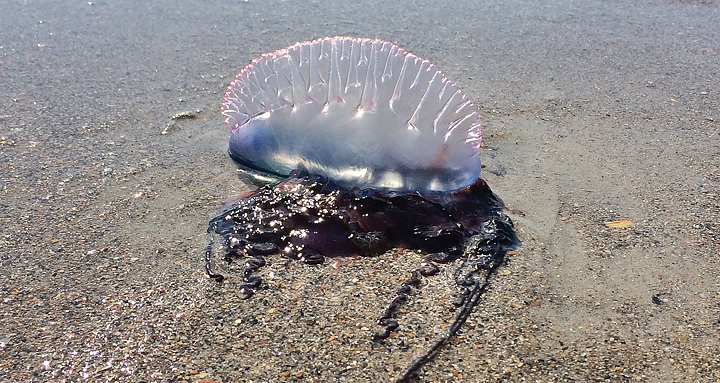Wrightsville Beach has seen a noticeable spike in stingray and jellyfish stings with lifeguards treating about a dozen stings a day over the past two weeks, a Wrightsville Beach lifeguard official said.
“Everyone I know is getting stung,” Wrightsville Beach Ocean Rescue Captain Jeremy Owens said. “It’s one of the worst years I’ve seen for jellyfish stings.”
Lifeguards often respond to “marine envenomation,” when sea creatures sting swimmers, surfers and other beachgoers, Owens said. The most common in Wrightsville Beach are jellyfish and stingrays.
Common jellyfish for New Hanover County shores are the sea nettle, the cannonball jellyfish, sometimes called the cauliflower jellyfish, the Portuguese man-of-war and the moon jellyfish, said University of North Carolina Wilmington assistant marine biology professor Robert Condon.
Owens said that the most recent rash of stings likely are the result of the box jellyfish, sometimes known as the sea wasp.
“The stings can be extremely painful,” Owens said.
Condon examined a photo of one jellyfish sting sent to Lumina News and said it could be either a box jellyfish or a Portuguese man-of-war, though he emphasized recognizing stings can be difficult without a personal examination of the wound.
“It’s quite hard to identify the species,” he said. “They all sting.”
One danger of box jellyfish is they are hard to spot in the water because they are clear. Often their tentacles will break off, but can still sting even though separated from the organism. Both Owens and Condon said the cannonball jellyfish, one of the most commonly spotted in Wrightsville Beach, also has the mildest sting.
If stung by a jellyfish, the first priority is to remove any tentacles still in the skin. Owens recommends using a gloved hand, credit card or plastic bag. Wrightsville Beach lifeguards will sometimes use a razor to remove the tentacles. Applying saline solution or salt water can also help with the sting. After that, the area can be washed with hot or cold water, whichever is most comfortable.
Another problem for beachgoers over recent weeks has been stingrays, Owens said, particularly in the early morning at high tide before swimmers scare them off. Lifeguards have treated at least three stingray stings in the past few weeks.
Stingrays often lie on the seafloor near the shore where they hunt for food like crab, Condon said. They generally don’t bother people but if they are stepped on they will throw their barb into the person’s foot.
A good way to avoid a stingray is to shuffle your feet while entering the ocean in the morning, giving the creature warning that you are approaching, Owens said.
While the stingray sting isn’t generally dangerous, it can be painful. If stung, the first priority is to remove the barb. Then, soaking the foot in very hot water can help take away the pain.
Both jellyfish and stingrays can create allergic reactions in some people, so if there shortness of breath or severe swelling it is best to see a doctor or call 911, Owens said.
While the recent spike in jellyfish stings may be bothersome to swimmers and surfers, it’s not indicative of any recent changes in jellyfish populations.
“It’s a myth that the jellyfish population is increasing,” said Condon, who noted the populations move in cycles and in a few years jellyfish populations should begin to decrease.
While the creatures do sting, Condon pointed out that they also serve an important role in marine life, including serving as food for sea turtles.
Condon said anyone who spots a jellyfish can report them to Jellywatch.org, which tracks jellyfish populations.
email [email protected]




